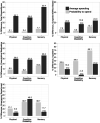Health spending among working-age immigrants with disabilities compared to those born in the US
- PMID: 26917103
- PMCID: PMC5072124
- DOI: 10.1016/j.dhjo.2016.01.007
Health spending among working-age immigrants with disabilities compared to those born in the US
Abstract
Background: Immigrants have disparate access to health care. Disabilities can amplify their health care burdens.
Objective/hypothesis: Examine how US- and foreign-born working-age adults with disabilities differ in their health care spending patterns.
Methods: Medical Expenditures Panel Survey yearly-consolidated files (2000-2010) on working-age adults (18-64 years) with disabilities. We used three operational definitions of disability: physical, cognitive, and sensory. We examined annual total, outpatient/office-based, prescription medication, inpatient, and emergency department (ED) health expenditures. We tested bivariate logistic and linear regression models to, respectively, assess unadjusted group differences in the propensity to spend and average expenditures. Second, we used multivariable two-part models to estimate and test per-capita expenditures adjusted for predisposing, enabling, health need and behavior indicators.
Results: Adjusted for age and sex differences, US-born respondents with physical, cognitive, sensory spent on average $2977, $3312, and $2355 more in total compared to their foreign-born counterparts (P < 0.01). US-born spending was also higher across the four types of health care expenditures considered. Adjusting for the behavioral model factors, especially predisposing and enabling indicators, substantially reduced nativity differences in overall, outpatient/office-based and medication spending but not in inpatient and ED expenditures.
Conclusions: Working-age immigrants with disabilities have lower levels of health care use and expenditures compared to their US-born counterparts. Affordable Care Act provisions aimed at increasing access to insurance and primary care can potentially align the consumption patterns of US- and foreign-born disabled working-age adults. More work is needed to understand the pathways leading to differences in hospital and prescription medication care.
Keywords: Disparities; Health care expenditures; Immigrants.
Copyright © 2016 Elsevier Inc. All rights reserved.
Figures


Similar articles
-
Comparison of Use of Health Care Services and Spending for Unauthorized Immigrants vs Authorized Immigrants or US Citizens Using a Machine Learning Model.JAMA Netw Open. 2020 Dec 1;3(12):e2029230. doi: 10.1001/jamanetworkopen.2020.29230. JAMA Netw Open. 2020. PMID: 33306118 Free PMC article. Clinical Trial.
-
Health care expenditures of immigrants in the United States: a nationally representative analysis.Am J Public Health. 2005 Aug;95(8):1431-8. doi: 10.2105/AJPH.2004.044602. Am J Public Health. 2005. PMID: 16043671 Free PMC article.
-
Cost of Public Health Insurance for US-Born and Immigrant Adults.JAMA Netw Open. 2023 Sep 5;6(9):e2334008. doi: 10.1001/jamanetworkopen.2023.34008. JAMA Netw Open. 2023. PMID: 37713197 Free PMC article.
-
Medical Expenditures on and by Immigrant Populations in the United States: A Systematic Review.Int J Health Serv. 2018 Oct;48(4):601-621. doi: 10.1177/0020731418791963. Epub 2018 Aug 8. Int J Health Serv. 2018. PMID: 30088434
-
Health Expenditures for Adults by Number of Treated Chronic Conditions, Race/Ethnicity, and Age, 2012.2015 Dec. In: Statistical Brief (Medical Expenditure Panel Survey (US)) [Internet]. Rockville (MD): Agency for Healthcare Research and Quality (US); 2001–. STATISTICAL BRIEF #485. 2015 Dec. In: Statistical Brief (Medical Expenditure Panel Survey (US)) [Internet]. Rockville (MD): Agency for Healthcare Research and Quality (US); 2001–. STATISTICAL BRIEF #485. PMID: 28783271 Free Books & Documents. Review.
Cited by
-
Disability, food insecurity by nativity, citizenship, and duration.SSM Popul Health. 2020 Jan 31;10:100550. doi: 10.1016/j.ssmph.2020.100550. eCollection 2020 Apr. SSM Popul Health. 2020. PMID: 32090167 Free PMC article.
-
Barriers and Facilitators of Access to Healthcare Among Immigrants with Disabilities: A Qualitative Meta-Synthesis.Healthcare (Basel). 2025 Feb 4;13(3):313. doi: 10.3390/healthcare13030313. Healthcare (Basel). 2025. PMID: 39942501 Free PMC article. Review.
-
Disparities in hospital smoking cessation treatment by immigrant status.J Ethn Subst Abuse. 2020 Jan-Mar;19(1):44-57. doi: 10.1080/15332640.2018.1446377. Epub 2018 May 4. J Ethn Subst Abuse. 2020. PMID: 29727588 Free PMC article.
References
-
- Agency for Healthcare Research and Quality National Healthcare Quality & Disparities Reports. 2014 http://www.ahrq.gov/research/findings/nhqrdr/index.html.
-
- US Department of Health Human Services, Office of Disease Prevention Health Promotion [May 19, 2015];Healthy People 2020. Disability and Health. 2015 http://www.healthypeople.gov/2020/topics-objectives/topic/disability-and....
-
- Brault MW. Americans with disabilities: 2010. US Department of Commerce, Economics and Statistics Administration, US Census Bureau; 2012. Census USBot.
-
- Institute of Medicine Committee on Disability in America . The future of disability in America. National Academies Press; Washington, DC.: 2007.
-
- Alley DE, Chang VW. THe changing relationship of obesity and disability, 1988-2004. JAMA. 2007;298(17):2020–2027. - PubMed
MeSH terms
Grants and funding
LinkOut - more resources
Full Text Sources
Other Literature Sources
Medical

